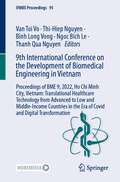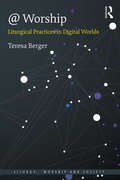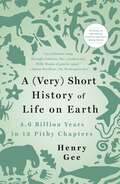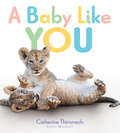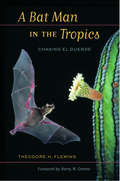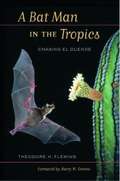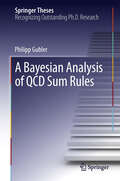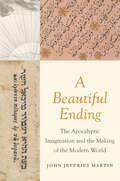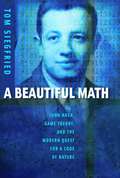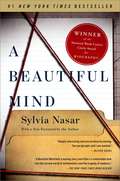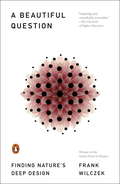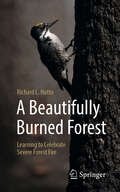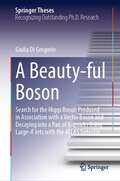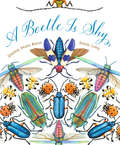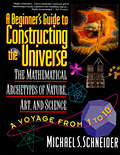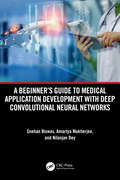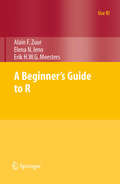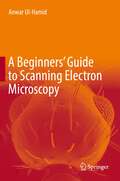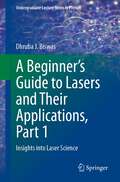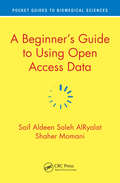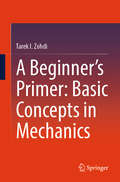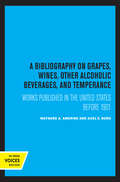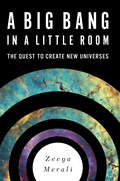- Table View
- List View
9th International Conference on the Development of Biomedical Engineering in Vietnam: Proceedings of BME 9, 2022, Ho Chi Minh City, Vietnam: Translational Healthcare Technology from Advanced to Low and Middle-Income Countries in the Era of Covid and Digital Transformation (IFMBE Proceedings #95)
by Thi-Hiep Nguyen Van Toi Vo Binh Long Vong Ngoc Bich Le Thanh Qua NguyenThis book presents cutting-edge research and developments in the field of biomedical engineering, with a special emphasis on results achieved in Vietnam and neighboring low- and middle-income countries. Covering both fundamental and applied research, and focusing on the theme of “Translational Healthcare Technology from Advanced to Low and Middle Income Countries in the Era of Covid and Digital Transformation”, it reports on the design, fabrication, and application of low-cost and portable medical devices, biosensors, and microfluidic devices, on improved methods for biological data acquisition and analysis, on nanoparticles for biological applications, and on new achievements in biomechanics, tissue engineering, and regeneration. It describes the developments of molecular and cellular biology techniques, neuroengineering techniques, and statistical and computational methods, including artificial intelligence, for biomedical applications. It also discusses strategies to address some relevant issues in biomedical education and entrepreneurship. Gathering the proceedings of the 9th International Conference on The Development of Biomedical Engineering in Vietnam, BME 9, held on December 27-29, 2022, in Ho Chi Minh, Vietnam, the book offers important answers to current challenges in the field and a source of inspiration for scientists, engineers, and researchers with various backgrounds working in different research institutes, companies, and countries.
@ Worship: Liturgical Practices in Digital Worlds (Liturgy, Worship and Society Series)
by Teresa BergerA host of both very old and entirely new liturgical practices have arisen in digital mediation, from the live-streaming of worship services and "pray-as-you-go" apps, to digital prayer chapels, virtual choirs and online pilgrimages. Cyberspace now even hosts communities of faith that exist entirely online. These digitally mediated liturgical practices raise challenging questions: Are worshippers in an online chapel really a community at prayer? Do avatars that receive digital bread and wine receive communion? @ Worship proposes a nuanced response to these sometimes contentious issues, rooted in familiarity with, and sustained attention to, actual online practices. Four major thematic lines of inquiry form the structure of the book. After an introductory chapter the following chapters look at digital presence, virtual bodies, and online participation; ecclesial communities in cyberspace; digital materiality, visuality, and soundscapes; and finally the issues of sacramental mediation online. A concluding chapter brings together the insights from the previous chapters and maps a way forward for reflections on digitally mediated liturgical practices. @ Worship is the first monograph dedicated to exploring online liturgical practices that have emerged since the introduction of Web 2.0. Bringing together the scholarly tools and insights of liturgical studies, constructive theology and digital media theories, it is vital reading for scholars of Theology and Religion with as well as Sociology and Digital Culture more generally.
A (Very) Short History of Life on Earth: 4.6 Billion Years in 12 Pithy Chapters
by Henry GeeIn the tradition of Richard Dawkins, Bill Bryson, and Simon Winchester—An entertaining and uniquely informed narration of Life's life story.In the beginning, Earth was an inhospitably alien place—in constant chemical flux, covered with churning seas, crafting its landscape through incessant volcanic eruptions. Amid all this tumult and disaster, life began. The earliest living things were no more than membranes stretched across microscopic gaps in rocks, where boiling hot jets of mineral-rich water gushed out from cracks in the ocean floor.Although these membranes were leaky, the environment within them became different from the raging maelstrom beyond. These havens of order slowly refined the generation of energy, using it to form membrane-bound bubbles that were mostly-faithful copies of their parents—a foamy lather of soap-bubble cells standing as tiny clenched fists, defiant against the lifeless world. Life on this planet has continued in much the same way for millennia, adapting to literally every conceivable setback that living organisms could encounter and thriving, from these humblest beginnings to the thrilling and unlikely story of ourselves.In A (Very) Short History of Life on Earth, Henry Gee zips through the last 4.6 billion years with infectious enthusiasm and intellectual rigor. Drawing on the very latest scientific understanding and writing in a clear, accessible style, he tells an enlightening tale of survival and persistence that illuminates the delicate balance within which life has always existed.
A Baby Like You
by Catherine ThimmeshSibert Medalist Catherine Thimmesh connects babies across our ecosystem with compelling photographs and a poetic text that shows how the everyday milestones babies take parallel animals in the world. For fans of Zooborns.
A Bat Man in the Tropics
by Theodore H. Fleming Harry W. GreeneThe euphoria of discovery is the only motivation many scientists need for studying nature and its secrets. Yet euphoria is rarely expressed in scientific publications. This book, a personal account of more than thirty years of fieldwork by one of the world's leading bat biologists, wonderfully conveys the thrill of scientific discovery. Theodore Fleming's work to document the lives and ecological importance of plant-visiting bats has taken him to the tropical forests of Panama, Costa Rica, and Australia, and to the lush Sonoran Desert of northwest Mexico and Arizona. This book tells the story of his fascinating career and recounts his many adventures in the field. Fleming weaves autobiographical reflections together with information on the natural history and ecology of bats and describes many other animals and plants he has encountered. His book details the stresses and rewards of life in scientific field camps, gives portraits of prominent biologists such as Dan Janzen and Peter Raven, and traces the development of modern tropical biology. A witness to the destruction and development of many of the forests he has visited throughout his career, Fleming makes a passionate plea for the conservation of these wild places.
A Bat Man in the Tropics: Chasing El Duende
by Theodore H. Fleming"This personal account of more than thirty years of fieldwork by one of the world's leading bat biologists wonderfully conveys the thrill of scientific discovery. Theodore Fleming's work to document the lives and ecological importance of plant-visiting bats has taken him to the tropical forests of Panama, Costa Rica, and Australia, and to the lush Sonoran Desert of northwest Mexico and Arizona.
A Bayesian Analysis of QCD Sum Rules (Springer Theses)
by Philipp GublerThe author develops a novel analysis method for QCD sum rules (QCDSR) by applying the maximum entropy method (MEM) to arrive at an analysis with less artificial assumptions than previously held. This is a first-time accomplishment in the field. In this thesis, a reformed MEM for QCDSR is formalized and is applied to the sum rules of several channels: the light-quark meson in the vector channel, the light-quark baryon channel with spin and isospin 1/2, and several quarkonium channels at both zero and finite temperatures. This novel technique of combining QCDSR with MEM is applied to the study of quarkonium in hot matter, which is an important probe of the quark-gluon plasma currently being created in heavy-ion collision experiments at RHIC and LHC.
A Bear Far from Home
by Susan FletcherThis poignant historical nonfiction book, about a polar bear that was gifted to King Henry III, beautifully shows the importance of respecting our natural world and its precious animals.Long ago, when kings and queens ruled much of the world, the king of Norway gave the king of England a bear. Imagine a polar bear at ease in her natural arctic world, her only home--until trappers capture her and take her to the king of England.Imagine a polar bear in her lonely new world, stuck in a cage. This small, enclosed space is her only home--until King Henry III decrees that she be brought to the Thames River every day to swim and fish.Imagine now this same polar bear dipping a curious paw in the river water, then leaping in with a joyful splash. And it is here, in this unfamiliar, faraway land, in one small way, that she finds home once again.
A Beautiful Ending: The Apocalyptic Imagination and the Making of the Modern World
by John Jeffries MartinAn award-winning historian&’s revisionary account of the early modern world, showing how apocalyptic ideas stimulated political, religious, and intellectual transformations &“A masterful synthesis of the prognostications of faith, knowledge, and politics on a global stage. Martin&’s book illuminates one of the enduring themes that shaped the medieval and early modern world.&”—Paula E. Findlen, Stanford University In this revelatory immersion into the apocalyptic, messianic, and millenarian ideas and movements that created the modern world, John Jeffries Martin performs a kind of empathic time travel, entering into the psyche, spirituality, and temporalities of a cast of historical actors in profound moments of discovery. He argues that religious faith—Christian, Jewish, and Muslim—did not oppose but rather fostered the making of a modern scientific spirit, buoyed along by a providential view of history and nature, and a deep conviction in the coming End of the World. Through thoughtful attention to the primary sources, Martin re‑reads the Renaissance, excavating a religious foundation at the core of even the most radical empirical thinking. Familiar icons like Ibn Khaldūn, Columbus, Isaac Luria, and Francis Bacon emerge startlingly fresh and newly gleaned, agents of a history formerly untold and of a modern world made in the image of its imminent end.
A Beautiful Math
by Tom SiegfriedMillions have seen the movie and thousands have read the book but few have fully appreciated the mathematics developed by John Nash's beautiful mind. Today Nash's beautiful math has become a universal language for research in the social sciences and has infiltrated the realms of evolutionary biology, neuroscience, and even quantum physics. John Nash won the 1994 Nobel Prize in economics for pioneering research published in the 1950s on a new branch of mathematics known as game theory. At the time of Nash's early work, game theory was briefly popular among some mathematicians and Cold War analysts. But it remained obscure until the 1970s when evolutionary biologists began applying it to their work. In the 1980s economists began to embrace game theory. Since then it has found an ever expanding repertoire of applications among a wide range of scientific disciplines. Today neuroscientists peer into game players' brains, anthropologists play games with people from primitive cultures, biologists use games to explain the evolution of human language, and mathematicians exploit games to better understand social networks. A common thread connecting much of this research is its relevance to the ancient quest for a science of human social behavior, or a Code of Nature, in the spirit of the fictional science of psychohistory described in the famous Foundation novels by the late Isaac Asimov. In A Beautiful Math, acclaimed science writer Tom Siegfried describes how game theory links the life sciences, social sciences, and physical sciences in a way that may bring Asimov's dream closer to reality.
A Beautiful Mind (Shooting Script Ser.)
by Sylvia Nasar**Also an Academy Award–winning film starring Russell Crowe and Jennifer Connelly—directed by Ron Howard** The powerful, dramatic biography of math genius John Nash, who overcame serious mental illness and schizophrenia to win the Nobel Prize.“How could you, a mathematician, believe that extraterrestrials were sending you messages?” the visitor from Harvard asked the West Virginian with the movie-star looks and Olympian manner. “Because the ideas I had about supernatural beings came to me the same way my mathematical ideas did,” came the answer. “So I took them seriously.” Thus begins the true story of John Nash, the mathematical genius who was a legend by age thirty when he slipped into madness, and who—thanks to the selflessness of a beautiful woman and the loyalty of the mathematics community—emerged after decades of ghostlike existence to win a Nobel Prize for triggering the game theory revolution. The inspiration for an Academy Award–winning movie, Sylvia Nasar’s now-classic biography is a drama about the mystery of the human mind, triumph over adversity, and the healing power of love.
A Beautiful Question: Finding Nature's Deep Design
by Frank WilczekDoes the universe embody beautiful ideas?Artists as well as scientists throughout human history have pondered this "beautiful question." With Nobel laureate Frank Wilczek as your guide, embark on a voyage of related discoveries, from Plato and Pythagoras up to the present. Wilczek's groundbreaking work in quantum physics was inspired by his intuition to look for a deeper order of beauty in nature. In fact, every major advance in his career came from this intuition: to assume that the universe embodies beautiful forms, forms whose hallmarks are symmetry--harmony, balance, proportion--and economy. There are other meanings of "beauty," but this is the deep logic of the universe--and it is no accident that it is also at the heart of what we find aesthetically pleasing and inspiring.Wilczek is hardly alone among great scientists in charting his course using beauty as his compass. As he reveals in A Beautiful Question, this has been the heart of scientific pursuit from Pythagoras, the ancient Greek who was the first to argue that "all things are number," to Galileo, Newton, Maxwell, Einstein, and into the deep waters of twentiethcentury physics. Though the ancients weren't right about everything, their ardent belief in the music of the spheres has proved true down to the quantum level. Indeed, Wilczek explores just how intertwined our ideas about beauty and art are with our scientific understanding of the cosmos.Wilczek brings us right to the edge of knowledge today, where the core insights of even the craziest quantum ideas apply principles we all understand. The equations for atoms and light are almost literally the same equations that govern musical instruments and sound; the subatomic particles that are responsible for most of our mass are determined by simple geometric symmetries. The universe itself, suggests Wilczek, seems to want to embody beautiful and elegant forms. Perhaps this force is the pure elegance of numbers, perhaps the work of a higher being, or somewhere between. Either way, we don't depart from the infinite and infinitesimal after all; we're profoundly connected to them, and we connect them. When we find that our sense of beauty is realized in the physical world, we are discovering something about the world, but also something about ourselves.Gorgeously illustrated, A Beautiful Question is a mind-shifting book that braids the age-old quest for beauty and the age-old quest for truth into a thrilling synthesis. It is a dazzling and important work from one of our best thinkers, whose humor and infectious sense of wonder animate every page. Yes: The world is a work of art, and its deepest truths are ones we already feel, as if they were somehow written in our souls.
A Beautifully Burned Forest: Learning to Celebrate Severe Forest Fire
by Richard L. HuttoIn this book, avian ecologist and former PBS Birdwatch host Richard Hutto challenges conventional wisdom by revealing the hidden beauty and ecological importance of severely burned forests. Drawing on extensive field research and compelling storytelling, Hutto uncovers one of nature&’s best-kept secrets: numerous species—including the black-backed woodpecker and the morel mushroom—thrive in conditions created only by intense wildfires. These and many other fire-dependent organisms have evolved to flourish in charred landscapes, a fact often overlooked by birdwatchers, land managers, and even fire researchers. Blending science, fieldwork, and reflections from a lifelong career, this book has the potential to transform how we perceive forest fires. It offers a fresh perspective on fire&’s role in maintaining biodiversity and invites readers to consider how revised land management practices could benefit both industry and the environment. Written in an engaging and accessible style, this book is ideal for birdwatchers, nature enthusiasts, fire managers, and anyone curious about the true role of fire in our ecosystems.
A Beauty-ful Boson: Search for the Higgs Boson Produced in Association with a Vector Boson and Decaying into a Pair of b-quarks Using Large-R Jets with the ATLAS Detector (Springer Theses)
by Giulia Di GregorioThe analysis described in this thesis is the search for the Higgs boson, decaying into bb pair, in the associated production with a vector boson, in the extreme Higgs boson transverse momentum region where the Higgs boson is reconstructed using the large-R jet technique. The use of the large-R jets allows to add a part of the phase space unexplored so far, which is particularly sensitive to possible new physics.The analysed data have been collected at LHC by the ATLAS detector between 2015 and 2018 at a centre-of-mass energy of √s = 13 TeV. The same dataset has been used to perform the differential pp → ZH and pp → WH cross-section measurements used to extract the information on the Higgs couplings and to put limits on Beyond the Standard Model effects.Furthermore the analysis has been re-used to perform a cross-section measurement of the diboson ZZ and WZ processes because the diboson and the Higgs processes have a similar topology. For the first time the ZZ(bb) and WZ(bb) cross-sections are measured at √s = 13 TeV and the observed cross-section measurements are consistent with the Standard Model predictions.
A Beetle Is Shy
by Dianna Hutts AstonThe award-winning duo of Dianna Hutts Aston and Sylvia Long team up again, this time creating a gorgeous look at the fascinating world of beetles. From flea beetles to bombardier beetles, an incredible variety of these beloved bugs are showcased here in all their splendor. Poetic in voice and elegant in design, this carefully researched and visually striking book is perfect for sparking children's imaginations in both classroom reading circles and home libraries. Plus, this is the fixed-format version, which looks almost identical to the print edition!
A Beginner's Guide to Constructing the Universe: The Mathematical Archetypes of Nature, Art, and Science
by Michael S. SchneiderDiscover how mathematical sequences abound in our natural world in this definitive exploration of the geography of the cosmosYou need not be a philosopher or a botanist, and certainly not a mathematician, to enjoy the bounty of the world around us. But is there some sort of order, a pattern, to the things that we see in the sky, on the ground, at the beach? In A Beginner's Guide to Constructing the Universe, Michael Schneider, an education writer and computer consultant, combines science, philosophy, art, and common sense to reaffirm what the ancients observed: that a consistent language of geometric design underpins every level of the universe, from atoms to galaxies, cucumbers to cathedrals. Schneider also discusses numerical and geometric symbolism through the ages, and concepts such as periodic renewal and resonance. This book is an education in the world and everything we can't see within it.Contains numerous b&w photos and illustrations.
A Beginner's Guide to Medical Application Development with Deep Convolutional Neural Networks
by Nilanjan Dey Amartya Mukherjee Snehan BiswasThis book serves as a source of introductory material and reference for medical application development and related technologies by providing the detailed implementation of cutting-edge deep learning methodologies. It targets cloud-based advanced medical application developments using open-source Python-based deep learning libraries. It includes code snippets and sophisticated convolutional neural networks to tackle real-world problems in medical image analysis and beyond.Features: Provides programming guidance for creation of sophisticated and reliable neural networks for image processing. Incorporates the comparative study on GAN, stable diffusion, and its application on medical image data augmentation. Focuses on solving real-world medical imaging problems. Discusses advanced concepts of deep learning along with the latest technology such as GPT, stable diffusion, and ViT. Develops applicable knowledge of deep learning using Python programming, followed by code snippets and OOP concepts. This book is aimed at graduate students and researchers in medical data analytics, medical image analysis, signal processing, and deep learning.
A Beginner's Guide to R: A Frequentist And Bayesian Perspective For Ecologists (Use R!)
by Elena N. Ieno Alain Zuur Erik MeestersBased on their extensive experience with teaching R and statistics to applied scientists, the authors provide a beginner's guide to R. To avoid the difficulty of teaching R and statistics at the same time, statistical methods are kept to a minimum. The text covers how to download and install R, import and manage data, elementary plotting, an introduction to functions, advanced plotting, and common beginner mistakes. This book contains everything you need to know to get started with R. "Its biggest advantage is that it aims only to teach R...It organizes R commands very efficiently, with much teaching guidance included. I would describe this book as being handy--it's the kind of book that you want to keep in your jacket pocket or backpack all the time, ready for use, like a Swiss Army knife." (Loveday Conquest, University of Washington) "Whilst several books focus on learning statistics in R..., the authors of this book fill a gap in the market by focusing on learning R whilst almost completely avoiding any statistical jargon...The fact that the authors have very extensive experience of teaching R to absolute beginners shines throughout." (Mark Mainwaring, Lancaster University) "Exactly what is needed...This is great, nice work. I love the ecological/biological examples; they will be an enormous help." (Andrew J. Tyne, University of Nebraska-Lincoln)
A Beginners' Guide to Scanning Electron Microscopy
by Anwar Ul-HamidThis book was developed with the goal of providing an easily understood text for those users of the scanning electron microscope (SEM) who have little or no background in the area. The SEM is routinely used to study the surface structure and chemistry of a wide range of biological and synthetic materials at the micrometer to nanometer scale. Ease-of-use, typically facile sample preparation, and straightforward image interpretation, combined with high resolution, high depth of field, and the ability to undertake microchemical and crystallographic analysis, has made scanning electron microscopy one of the most powerful and versatile techniques for characterization today. Indeed, the SEM is a vital tool for the characterization of nanostructured materials and the development of nanotechnology. However, its wide use by professionals with diverse technical backgrounds—including life science, materials science, engineering, forensics, mineralogy, etc., and in various sectors of government, industry, and academia—emphasizes the need for an introductory text providing the basics of effective SEM imaging.A Beginners’ Guide to Scanning Electron Microscopy explains instrumentation, operation, image interpretation and sample preparation in a wide ranging yet succinct and practical text, treating the essential theory of specimen-beam interaction and image formation in a manner that can be effortlessly comprehended by the novice SEM user. This book provides a concise and accessible introduction to the essentials of SEMincludes a large number of illustrations specifically chosen to aid readers' understanding of key conceptshighlights recent advances in instrumentation, imaging and sample preparation techniquesoffers examples drawn from a variety of applications that appeal to professionals from diverse backgrounds.
A Beginner’s Guide to Lasers and Their Applications, Part 1: Insights into Laser Science (Undergraduate Lecture Notes in Physics)
by Dhruba J. BiswasThis two-volume book provides an enriching insight into the laser, covering different types of lasers, the basic science behind the technology, their role at the cutting-edge of current scientific research, and their wide-ranging applications. With just high school physics as a prerequisite and favoring qualitative yet scientifically sound explanations over high-level mathematics, this book is aimed at a broad spectrum of readers in physics, chemistry, engineering, medicine, and biology. Its engaging and lucid presentation is enhanced with plenty of illustrations, making the world of the laser accessible to undergraduate students in the sciences and any other inquisitive readers with high school physics under their belts. Furthermore, the text is often laced with anecdotes, picked from history, that are bound to pique the minds of the readers. It is ideal for self-study or as a complement to courses on optics and optoelectronics. This volume, Part 1 of 2, explains the fundamentals of optics, what a laser is, how it works, and what is unique about the light it emits, from fundamental quantum theory through population inversion and cavity to common laser types. It is followed by Part 2 which depicts the many advances in science enabled by the laser, including spectroscopy, nonlinear optics, optical cooling and trapping, and optical tweezers, among many others, and provides a glimpse into the ways that the laser affects our lives via its uses in medicine, manufacturing, the nuclear industry, energy, defence, communication, ranging, pollution monitoring, art conservation, fashion, beauty, and entertainment.
A Beginner’s Guide to Using Open Access Data (Pocket Guides to Biomedical Sciences)
by Saif Aldeen AlRyalat Shaher MomaniOpen Access Data is emerging as a source for cutting edge scholarship. This concise book provides guidance from generating a research idea to publishing results. Both young researchers and well-established scholars can use this book to upgrade their skills with respect to emerging data sources, analysis, and even post-publishing promotion. At the end of each chapter, a tutorial simulates a real example, allowing readers to apply what they learned about accessing open data, and analyzing this data to reach the results. This book can be of use by established researchers analyzing data, publishing, and actively promoting ongoing and research. Key selling features: Describes the steps, from A-Z, for doing open data research Includes interactive tutorials following each chapter Provides guidelines for readers so that they can use their own accessed open data Reviews recent software and websites promoting and enabling open data research Supplements websites which update recent open data sources
A Beginner’s Primer: Basic Concepts in Mechanics
by Tarek I. ZohdiAs we enter an exciting new era in industrial design, simulation, and manufacturing, a clear understanding of mechanics of solids is needed now more than ever. This primer is a condensed synopsis of basic undergraduate mechanics and is designed to supplement classical textbooks in this area. The focus is on the essentials of mechanics, specifically: • The concept of stress. • Stress-strain relationships. • Failure theory. • Axial loading of a rod. • Transverse (bending) loading of a beam. • Industrial application: modeling of 3D printing. • Transverse shear stresses. • Torsional loading of a rod. • Pressure vessels. • Buckling of columns. • The basics of finite element methods. • A unifying concept: continuum mechanics.
A Bibliography on Grapes, Wines, Other Alcoholic Beverages, and Temperance: Works Published in the United States Before 1901 (UC Publications in Catalogs and Bibliographies #12)
by M. A. Amerine Axel E. BorgThis title is part of UC Press's Voices Revived program, which commemorates University of California Press’s mission to seek out and cultivate the brightest minds and give them voice, reach, and impact. Drawing on a backlist dating to 1893, Voices Revived makes high-quality, peer-reviewed scholarship accessible once again using print-on-demand technology. This title was originally published in 1996.
A Big Bang in a Little Room: The Quest to Create New Universes
by Zeeya MeraliAn award-winning science writer takes us into the lab to answer some of life's biggest questions: How was the universe created? And could we create our own?What if you could become God, with the ability to build a whole new universe? As startling as it sounds, modern physics suggests that within the next two decades, scientists may be able to perform this seemingly divine feat-to concoct an entirely new baby universe, complete with its own physical laws, star systems, galaxies, and even intelligent life. A Big Bang in a Little Room takes the reader on a journey through the history of cosmology and unravels-particle by particle, theory by theory, and experiment by experiment-the ideas behind this provocative claim made by some of the most respected physicists alive today. Beyond simply explaining the science, A Big Bang in a Little Room also tells the story of the people who have been laboring for more than thirty years to make this seemingly impossible dream a reality. What has driven them to continue on what would seem, at first glance, to be a quixotic quest?This mind-boggling book reveals that we can nurse other worlds in the tiny confines of a lab, raising a daunting prospect: Was our universe, too, brought into existence by a daring creator?
A Biogeoscience Approach to Ecosystems
by Johnson Martin Edward A. Yvonne E.Biogeoscience is a rapidly growing interdisciplinary field that aims to bring together biological and geophysical processes. This book builds an enhanced understanding of ecosystems by focusing on the integrative connections between ecological processes and the geosphere, hydrosphere and atmosphere. Each chapter provides studies by researchers who have contributed to the biogeoscience synthesis, presenting the latest research on the relationships between ecological processes, such as conservation laws and heat and transport processes, and geophysical processes, such as hillslope, fluvial and aeolian geomorphology, and hydrology. Highlighting the value of biogeoscience as an approach to understand ecosystems, this is an ideal resource for researchers and students in both ecology and the physical sciences.
